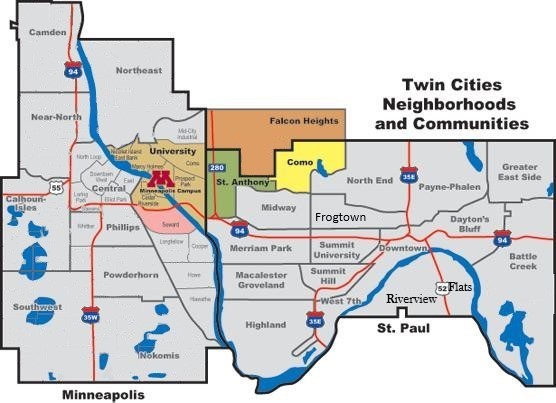Difference between revisions of "Maps"
DesignAdmin (talk | contribs) |
DesignAdmin (talk | contribs) |
||
| Line 5: | Line 5: | ||
== Demographics == | == Demographics == | ||
| − | + | The area is commonly known as the Twin Cities after the metro’s two largest cities, Minneapolis and Saint Paul. Minnesotans often refer to the two together simply as "the cities". It has the second largest economy in the Midwest. | |
| + | |||
| + | The two major cities in the metropolitan area, Minneapolis and Saint Paul, are independent municipalities with defined borders. Minneapolis sits mostly on the west side of the Mississippi River on lake-covered terrain. Although a majority of the city is residential neighborhoods, it has a downtown area with some new growth, especially in the Mill District and the Warehouse District. Minneapolis also has a popular uptown area. Saint Paul, which sits mostly on the east side of the river, has quaint tree-lined neighborhoods, a vast collection of well-preserved late-Victorian architecture, and a number of colleges. Both cities are known for their natural features of woods, lakes, hills and creeks. | ||
| + | |||
| + | Originally inhabited by Ojibwe and Dakota groups, the cities were subsequently settled by many groups of Europeans. Minneapolis was strongly influenced by early Scandinavian and Lutheran settlers, while Saint Paul was settled predominantly by French, Irish and German Catholic communities. Today, both urban areas are home to a few new immigrant communities, including Somali, Hmong, Oromo, Cameroonians, and Liberian groups. | ||
| + | |||
| + | === Total Population as of 2014 === | ||
===== Minneapolis: 394,424 ===== | ===== Minneapolis: 394,424 ===== | ||
Revision as of 14:57, 15 January 2022
This map represents the major neighborhoods of the Twin Cities, with the exceptions of Wayzata, which is to the west of Minneapolis, the Minneapolis-St. Paul International Airport which is tucked into the little square at the bottom of the map, Fort Snelling and the Fort Snelling State Park below the airport, Bloomington south of Minneapolis, and Prior Lake which is much, much further south.
Demographics
The area is commonly known as the Twin Cities after the metro’s two largest cities, Minneapolis and Saint Paul. Minnesotans often refer to the two together simply as "the cities". It has the second largest economy in the Midwest.
The two major cities in the metropolitan area, Minneapolis and Saint Paul, are independent municipalities with defined borders. Minneapolis sits mostly on the west side of the Mississippi River on lake-covered terrain. Although a majority of the city is residential neighborhoods, it has a downtown area with some new growth, especially in the Mill District and the Warehouse District. Minneapolis also has a popular uptown area. Saint Paul, which sits mostly on the east side of the river, has quaint tree-lined neighborhoods, a vast collection of well-preserved late-Victorian architecture, and a number of colleges. Both cities are known for their natural features of woods, lakes, hills and creeks.
Originally inhabited by Ojibwe and Dakota groups, the cities were subsequently settled by many groups of Europeans. Minneapolis was strongly influenced by early Scandinavian and Lutheran settlers, while Saint Paul was settled predominantly by French, Irish and German Catholic communities. Today, both urban areas are home to a few new immigrant communities, including Somali, Hmong, Oromo, Cameroonians, and Liberian groups.
Total Population as of 2014
Minneapolis: 394,424
- White: 63.8%
- Black or African American: 18.6%
- Hispanic or Latino (of any race): 10.5%
- Asian: 5.6%
- Some other race: 5.6%
- Two or more races: 4.4%
- American Indian: 2.0%
Saint Paul: 291,728
- White: 66.7%
- Black or African American: 13.5%
- Hispanic or Latino (of any race): 8.9%
- Asian: 12.4%
- Two or more races: 3.7%
- Some other race: 2.9%
- American Indian or Alaska Native: 0.8%
